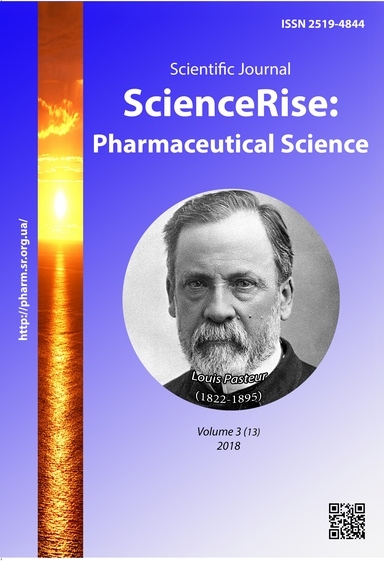Investigation of food supplements with preservative e211 (sodium benzoate) using thin-layer chromatography
DOI:
https://doi.org/10.15587/2519-4852.2018.135758Keywords:
thin-layer chromatography, food supplements, sodium benzoate, qualitative and quantitative determinationAbstract
Sodium benzoate is often chosen for the manufacture of liquid food supplements as preservative due to its antimicrobial effect against a large number of microorganisms. Permissible sodium benzoate amount in liquid food supplements is up to 2000 mg/l.
Methods. For investigation six liquid food supplements, containing sodium benzoate were randomly chosen. Analysis was performed using CAMAG Twin Chamber, TLC Silica Gel 60 F254 glass plates, solvent system (chloroform – ethanol 9:1) and the UV-light (254 nm) for visualization.
Results. Methods for visualisation and solvent system were selected using the reference solutions. Sodium benzoate was identificated by Rf = 0.76, it’s quantity was determined by calibration. Validated methodics was adapted for identification of sodium benzoate in liquid food supplements. The amount of sodium benzoate in all investigated objects was analysed and did not exceed the permissible amount.
Conclusions. Selected methodics are suitable for qualitative and quantitative evaluation of sodium benzoate in liquid food supplements
References
- Gultekin, F., Doguc, D. K. (2012). Allergic and Immunologic Reactions to Food Additives. Clinical Reviews in Allergy & Immunology, 45 (1), 6–29. doi: http://doi.org/10.1007/s12016-012-8300-8
- Del Olmo, A., Calzada, J., Nuтez, M. (2015). Benzoic acid and its derivatives as naturally occurring compounds in foods and as additives: Uses, exposure, and controversy. Critical Reviews in Food Science and Nutrition, 57 (14), 3084–3103. doi: http://doi.org/10.1080/10408398.2015.1087964
- Flores, N., Jimenez, I. A., Gimenez, A., Ruiz, G., Gutierrez, D., Bourdy, G., Bazzocchi, I. L. (2008). Benzoic Acid Derivatives fromPiperSpecies and Their Antiparasitic Activity. Journal of Natural Products, 71 (9), 1538–1543. doi: http://doi.org/10.1021/np800104p
- Del Olmo, A., Calzada, J., Nunez, M. (2015). Benzoic acid and its derivatives as naturally occurring compounds in foods and as additives: Uses, exposure, and controversy. Critical Reviews in Food Science and Nutrition, 57 (14), 3084–3103. doi: http://doi.org/10.1080/10408398.2015.1087964
- Boukarim, C., Abou Jaoude, S., Bahnam, R., Barada, R., Kyriacos, S. (2009). Preservatives in liquid pharmaceutical preparations. Drug Testing and Analysis, 1 (3), 146–148. doi: http://doi.org/10.1002/dta.28
- COMMISSION REGULATION (EU) No 1129/2011 of 11 November 2011 amending Annex II to Regulation (EC) No 1333/2008 of the European Parliament and of the Council by establishing a Union list of food additives (2011). Official Journal of the European Union. Available at: http://eur-lex.europa.eu/legal-content/EN/TXT/PDF/?uri=CELEX:32011R1129&from=LT
- Beezhold, B. L., Johnston, C. S., Nochta, K. A. (2012). Sodium Benzoate–Rich Beverage Consumption is Associated With Increased Reporting of ADHD Symptoms in College Students. Journal of Attention Disorders, 18 (3), 236–241. doi: http://doi.org/10.1177/1087054712443156
- Khan, S. H., Murawski, M. P., Sherma, J. (1994). Quantitative High Performance Thin Layer Chromatographic Determination of Organic Acid Preservatives in Beverages. Journal of Liquid Chromatography, 17 (4), 855–865. doi: http://doi.org/10.1080/10826079408013373
- Ma, Y., Yeung, E. S. (1990). Determination of components in beverages by thin-layer chromatography: An undergraduate analytical chemistry experiment. Journal of Chemical Education, 67 (5), 428–429. doi: http://doi.org/10.1021/ed067p428
- Moffat, A. C., Osselton, M. D., Widdop, B. (2011). Clarke‘s Analysis of Drugs and Poisons. London: Pharmaceutical Press, 2473.
- ICH Harmonised Tripartite Guideline. Validation of Analytical Procedures: Text and Methodology. Available at: https://www.ich.org/fileadmin/Public_Web_Site/ICH_Products/Guidelines/Quality/Q2_R1/Step4/Q2_R1__Guideline.pdf
Downloads
Published
How to Cite
Issue
Section
License
Copyright (c) 2018 Juste Gedziute, Mindaugas Marksa, Augusta Zevzikoviene, Vaidas Skyrius, Andrejus Zevzikovas

This work is licensed under a Creative Commons Attribution 4.0 International License.
Our journal abides by the Creative Commons CC BY copyright rights and permissions for open access journals.








